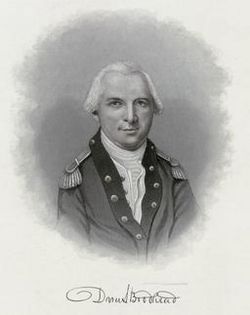Brodhead's Coshocton expedition facts for kids
Quick facts for kids Coshocton Expedition |
|||||||
|---|---|---|---|---|---|---|---|
| Part of American Revolutionary War | |||||||
 Daniel Brodhead, the Continental Army commander of Fort Pitt who led the Coshocton Expedition |
|||||||
|
|||||||
| Belligerents | |||||||
Pennsylvania Militia |
|||||||
| Commanders and leaders | |||||||
| Daniel Brodhead Gelelemend |
Captain Pipe | ||||||
| Strength | |||||||
| 150 Continental regulars 134 militia |
80 | ||||||
| Casualties and losses | |||||||
| Unknown | 36 killed, 20 prisoners | ||||||
The Coshocton Expedition was a military action during the American Revolutionary War. It happened in April 1781, near what is now Coshocton, Ohio. American forces, led by General Daniel Brodhead, attacked Lenape villages. They destroyed settlements and caused many deaths. This event is also known as Brodhead's Coshocton Expedition.
Contents
The Expedition Begins
On April 7, 1781, General Brodhead began his journey. He led about 150 regular soldiers and 134 militia members. They traveled along the Ohio River. Their first goal was to secure an alliance with the Lenape Turtle Clan. This group lived in the village of Gekelmukpechunk, now called Newcomerstown, Ohio.
A Change in Plans
The Lenape Wolf Clan had been attacking American settlers. This made many of Brodhead's soldiers want to get revenge. So, the mission changed from making friends to a military attack. When Brodhead reached Gekelmukpechunk, he asked to meet with the village chiefs. Three chiefs came to talk with him.
Unfortunately, a militiaman named Lewis Wetzel attacked one of the peaceful chiefs. This happened just as the chief crossed the river to meet Brodhead. Fearing a large, unplanned battle, Brodhead decided to leave. He then focused his troops on their original target: Coshocton.
Attacking Lenape Villages
On April 20, Brodhead and his men continued their march. Some Lenape who were allied with the U.S. joined them. They first attacked and destroyed a village called Indaochaic. This village was also known as Lichtenau. It was a settlement of peaceful Moravian Christian Lenape.
The Attack on Coshocton
After Lichtenau, the troops went to a nearby village. This village was called Goschachgunk, which is now Coshocton, Ohio. Lenape Chief Gelelemend helped Brodhead's forces. Brodhead divided his soldiers into three groups. They then attacked the village.
During the first night, 16 Lenape warriors were captured. They were taken south of the village and killed. Another 20 Lenape were killed during the battle. Twenty civilians were also taken as prisoners. Five of these prisoners were Moravian Christian Lenape. They were later released.
Protecting Other Villages
Colonel Brodhead and Colonel Davis Shepherd did not attack other Moravian Christian settlements. These included Schoenbrunn, Gnadenhutten, and Salem. These villages housed Christian Lenape and missionaries like John Heckewelder. Brodhead stated that these Lenape had acted honorably during the war. His soldiers even received food from these peaceful villages. After the attack on Coshocton, Brodhead felt his mission was complete. He and his troops then returned to Pennsylvania.
After the Expedition
In 1782, a group of colonists from Pennsylvania returned to the area. This was a private militia, mostly settlers. They wanted to get revenge for attacks on settlers in Western Pennsylvania. They falsely promised protection to the Moravian Christian Lenape and Moravian Christian Mahicans.
The Gnadenhutten Massacre
The Pennsylvania militia then attacked the peaceful Moravian Christian settlement of Gnadenhutten. This terrible event became known as the Gnadenhutten massacre. Many people who had survived the attack on Lichtenau had moved to Gnadenhutten. Those who were killed in this massacre are remembered as Christian martyrs.
Today, there is a historical marker in Coshocton, Ohio. It is located at 40° 16.554' N, 81° 50.659' W.

